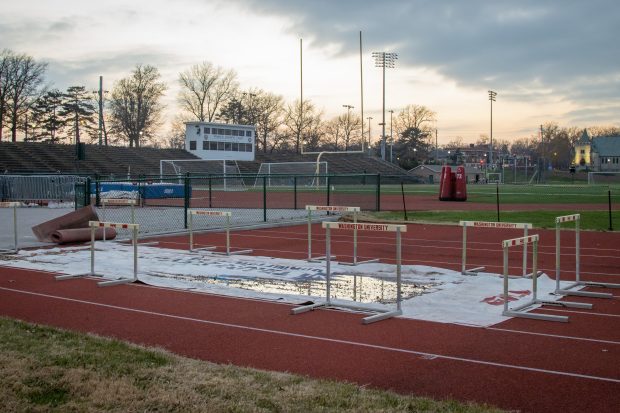Sports | Track and Field
‘I couldn’t be prouder as a coach’: How members of the track team helped each other overcome quarantine hurdles
As a Division III national champion in the triple jump, senior Eka Jose is used to spending her fall seasons going to practice every day, solidifying her technique in the sandpit and preparing for the upcoming winter indoor track season. Instead, this November, she was in a situation that hundreds of Washington University students across campus also faced: she found herself in quarantine. Trapped in a room with no face-to-face interactions and unable to go outside, she did the only thing that she could—she did a Zoom workout. That one room turned into a bedroom, a kitchen, an office and a gym. She just had to hope that it didn’t put her behind for a potential upcoming competition season.
Quarantine is stressful for all students, but student-athletes have the extra pressure of maintaining personal fitness despite not being able to access the typical resources that they usually need for training. The limitations differ a lot from sport to sport and depend on where student-athletes are in their training cycles. Still, all sports rely on consistently maintaining strength and fitness, so roadblocks are an added stressor. Jose and a teammate, sophomore jumper Kaitlin Day, had to overcome that challenge.
 Curran Neenan | Student Life
Curran Neenan | Student Life Hurdles stand unused on Francis Field on a recent late afternoon. Athletes in quarantine have had to find new ways to stay in shape.
Day was called by a contact tracer and ended up quarantining for 11 days. She had never had any COVID-19 exposure before, so she wasn’t sure what to expect and didn’t have very good information. “We’re all kind of getting information from multiple places,” she said. “It was just from all these different sources that it was difficult to kind of pinpoint who we should contact if we had questions.”
In terms of maintaining fitness while in quarantine, it was impossible to replicate the conditions needed for technical practice. Yet it was also a psychological shift for athletes who were used to spending time outside and pushing themselves to their limits. “I think that drastic shift in my lifestyle was a little bit of a shock to me, and I kind of went crazy some days,” Day said. She said the random workouts throughout the day were helpful, but it was still a culture shock to be indoors for so long.
Other members of the track community made the experience less isolating. One of the track coaches was quarantined as well, and Jose and Day were able to have virtual game nights with other athletes, building a sense of community despite the confinement. The teammates “grew a lot closer during those 14 days because we were just each other’s strongest support system,” Jose said.
Although the University did give students a packet with recommended items, Day and Jose realized that students weren’t seeing these items until too late. Along with other teammates, they decided to make a list of tips to help student-athletes who found themselves in a similar situation.
The group made a “Quarantine Survival Guide: created by people who made it through, so you can too.” The guide includes commonly forgotten items (snacks has three exclamation points), how to make the most out of a space and numbers to call. Day felt that it was important to give a student perspective from people who had been through the whole process themselves. The students hoped that if others had these resources, the experience would be less stressful earlier on.
With the help of track and field head coach Jeff Stiles, the group’s list has been spread around the team. “I am so proud of that group to think that, when you first get out of quarantine, the first thing you want to do is go create a document to help other people,” Stiles said. “I couldn’t be prouder as a coach. That’s a big deal. That should be celebrated.”
